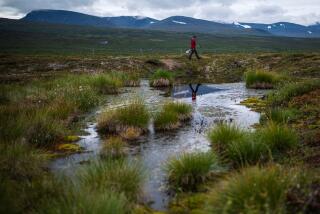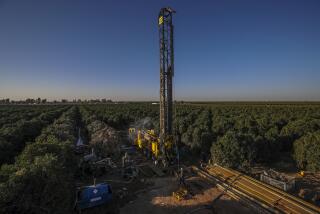Arctic’s Loss of Sea Ice Linked to Warming Trend
- Share via
The historic loss of sea ice seen in the Arctic in recent years is tied to widespread warming in the polar region that is increasing at a rate of more than 2 degrees per decade, according to a NASA satellite study released Thursday.
Last year, the summer ice that normally clogs Arctic seas was at historically low levels. This summer, the ice remained at near record lows, and the Arctic’s largest ice shelf cracked apart.
Researchers have suspected the loss of ice was due to warmer temperatures but had only spotty measurements on which to base their conclusions.
The new study, which will be published Nov. 1 in the Journal of Climate, used a polar-orbiting satellite from the National Oceanic and Atmospheric Administration to measure surface temperatures throughout the Arctic.
The study found temperatures over sea ice have been gradually rising over the last 100 years. But in the last 20 years, the temperatures have been rising eight times faster.
“The Arctic is in the process of being transformed,” said Josefino Comiso, the researcher at NASA’s Goddard Space Flight Center in Greenbelt, Md., who conducted the study.
In another study last year, Comiso reported that the Arctic’s usually thick, year-round sea ice was disappearing at a rate of 9% per decade.
Earlier reports from submarine data showed that Arctic ice in the 1990s was about 3 feet thinner than it had been decades before.
The new satellite data revealed that Arctic warming is not consistent. Although the area near Alaska and western Canada has warmed, the area around Greenland has cooled slightly. Still, the warming has created much more open water in the Arctic in recent years.
The new study is one of a number of reports -- from scientists, Inuit natives, boat captains and Cold War submarine records -- suggesting that the Arctic is changing in dramatic ways. But because much of the area is inaccessible, it has been difficult for scientists to get a large-scale picture of the changes, said Waleed Abdalati, who oversees NASA’s polar-monitoring efforts.
Because the changes are so sudden and are likely to have a global impact on weather and crops, NASA is turning considerable satellite resources toward the Earth’s polar regions. “With satellite data, we can study the whole area in glorious detail,” Comiso said.
Interest in the region is becoming widespread among other government agencies as well.
The National Science Foundation, NOAA, NASA and the departments of Agriculture, Defense, Energy and the Interior plan to spend about $10 million a year to support a program called SEARCH, or Study of Environmental Arctic Change, which will track changes in the Arctic’s oceans, atmosphere, land and ice. The program includes a monitoring station at the North Pole and should provide a long-term record of modern change, something scientists lack.
“Ten years ago, we were trying to understand what appeared to be a pretty static system,” said SEARCH director Jamie Morison, an oceanographer at the University of Washington. “Now, it’s perfectly clear the Arctic environment has changed.... And if we’re going to understand it, we have to be able to monitor it.”
Chief among questions is what is causing the melting and what role the human production of greenhouse gases, such as carbon dioxide, may be playing. Scientists say the world’s ice is partly responding to natural changes, such as the gradual warming over the last 150 years as Earth has emerged from a cool period known as the Little Ice Age.
The Earth’s most massive glaciers can take centuries to respond to warming, so many scientists believe their changes are more closely tied to natural cycles of warming and cooling. But smaller mountain glaciers and sea ice are affected by more recent climate change and warming.
“The general consensus of the climate community is that at least part of this [Arctic change] is due to human impact.... How much is a matter of debate,” said Mark Serreze, an expert on Arctic snow and ice at the University of Colorado at Boulder.
The picture is complicated by an atmospheric pattern called the North Atlantic Oscillation or Arctic Oscillation. This natural pattern is normally quite variable, but for the last 20 years has been stuck in a phase that leads to warmer temperatures over much of the Arctic.
Recent research suggests that the pattern may be stuck because greenhouse gases and increased ozone levels caused by human pollution are influencing it, further entangling the relationship between human and natural factors in climate change.






